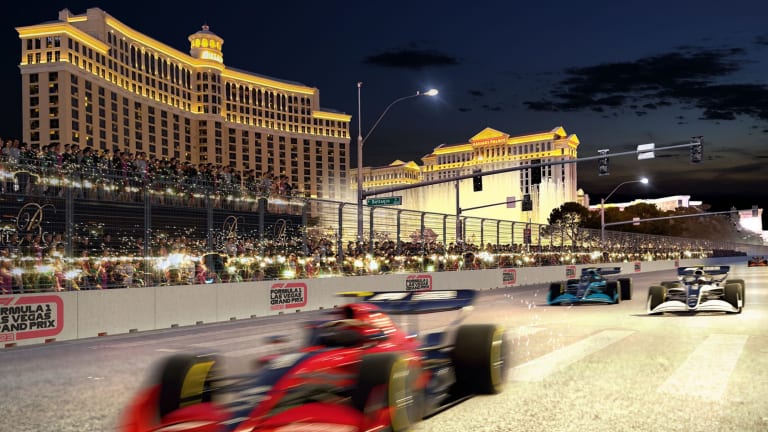
Why Las Vegas will be like no other F1 race ever held in the U.S.

Last week’s announcement of the return of the Formula 1 World Championship to Las Vegas in November 2023 has been met with a well-deserved share of fan anticipation and media buzz.
Already home to a plethora of world-class resorts and hospitality, adding a F1 race adds a new dimension to the continued diversity of entertainment options in Sin City.
With thousands of hotel rooms on the Las Vegas Strip with views of the track, and world-class restaurants and entertainment and hospitality lining the 3.8-mile circuit, the Las Vegas Grand Prix has the potential to become one of the most iconic races on the Formula 1 calendar - an American Monaco of sorts.
After all, the track layout consists of what is sure to become a legendary 1.2-mile run down the Las Vegas Strip, past the Venetian, Mirage, and Bellagio hotels, where top speeds are expected to reach more than 200 mph, something that seems unthinkable from a logistics perspective.
But don't forget that this isn’t Las Vegas’ first appearance on the F1 calendar. In 1981 and 1982, the World Championship Season finale was contested in the so-called Adult Disneyland, too.
In a parking lot.
Yes, the then-named Caesars Palace Grand Prix, was contested on a 2.3-mile circuit laid out in the Caesars Palace Resort parking lot in just 45 days.
The circuit was repetitive and boring, held during the day, subjecting drivers and cars to the extreme desert heat. Combine this with the fact that the track was counter-clockwise, while most other circuits on the calendar were clockwise.
This led to extreme physical strain for the drivers, leading to something that was dubbed “Las Vegas Neck”, and cemented an overall miserable time for the drivers and crews. Some called it the “worst circuit” F1 has ever seen. And attendance numbers were dismal.
Also, combine that with the fact that In 1981, Las Vegas wasn’t really, “Las Vegas”. Still a somewhat sleepy gambling town, outside of a few larger resorts like the International and MGM Grand, the super resorts of today were far away in vision and realization. It was only with the arrival of the Mirage in 1989 that the Strip started to hurtle towards its current place in the American entertainment industry.
So, what happened? In 1981, a full-season long team orders dispute between Williams drivers Alan Jones and Carlos Reutemann (who just needed to finish in front of title contender Nelson Piquet in Vegas to win the world driver’s championship) resulted in Jones doing little to help Reutemann hold on to his championship lead. Jones won the race, and Reutemann lost the title to Nelson Piquet by a single point. Yes, politics were alive and well in Formula 1 even then.
Piquet for his trouble was so exhausted after the race, it took him 15 minutes to leave the car and he was unable to stand for the post-race press conference. Only half the cars entered would ultimately finish.
The 1982 race, held at the end of a turbulent and tragic season, was won by Michele Alboreto in a Tyrrell, a shock win for a season that would see 11 different drivers win in 16 races. It also turned out to be the last F1 race for American Mario Andretti, who retired after 26 laps with a suspension issue.
The championship went to Keke Rosberg, who had replaced Reutemann as top driver at Williams earlier in the season. (Sidebar, the 1982 F1 Season Review video is a fascinating watch if you can find it, narrated with deep sarcasm by Australian journalist Clive James)
After two years of the Las Vegas experiment, the F1 moved the next attempt at a second US race to Dallas for 1984. This race ultimately fared little better, with similar heat issues to Las Vegas and poor track conditions, resulting in only 7 of 26 starters finishing the race.
The visual of Nigel Mansell passing out while trying to push his Lotus across the finish line for the final race point was the most noteworthy part of an otherwise forgettable weekend.
In general, after the last race at Watkins Glen in 1980, the US Grand Prix date struggled to find a long term home using street circuits with runs at Long Beach (1977-1983), the two "street courses" in Vegas (1981-82), the one Dallas race (1984), Detroit (1982-1988) and Phoenix (1990-1991), none of which were particularly successful in terms of fan interest, attendance, quality of race or driver satisfaction (Long Beach later grew into a crown jewel of the IndyCar calendar, and is still one of the top series dates today).
So far, at least, it looks like the new Las Vegas race will likely have few of these challenges.
The track is much longer. The average speed will be much faster. The trackside location the circuit will pass by (including Caesars Palace) will make the photographs memorable and appealing to the social media crowd.
And in terms of Las Vegas, it feels like the entertainment capital is now having a “moment”. Along with megaresorts with every possible theme and types of accommodations, other major league sports making a long-term commitment to the city (including the Raiders NFL football team and the Golden Knights NHL hockey team), and many more non-gambling entertainment options, it starts to make a full race weekend stay seem extremely appealing to more and more demographics.
Add to this the fact that the race will be run on a Saturday night, a rarity in Formula 1 (the first time since 1985, to be exact), and all of these factors look to combine to make the Las Vegas Grand Prix one to count on when tickets go on sale later this year.
Let’s just leave the parking lots to the rental cars this time.